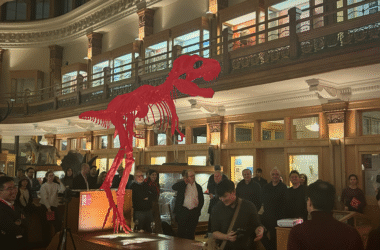McGill professors presented their scientific research to crowds of students in the Redpath Museum at the 29th iteration of Soup and Science from Jan. 13–17. After snacking on complementary soup and sandwiches, writers from The McGill Tribune compiled highlights from the week.
Nutrient cycling and ecosystem science
Fiona Soper, assistant professor in the Department of Biology, just started at McGill this semester, bringing the Soper Lab with her. Soper specializes in ecosystem science, drawing on plant physiology and biogeochemistry to explore the ways in which plants interact with their environment. In particular, Soper analyzes nutrient cycling processes to understand how plants respond to climate change.
“One of the big questions in ecosystem science is the extent to which plants can capitalize on having more [carbon dioxide] in the atmosphere to increase their growth and to change the trajectory of climate change,” Soper said.
An upcoming project will involve field and lab work on the mechanisms by which tropical plants scavenge for nutrients in high carbon environments, which will take the Soper Lab to the slopes of a volcano in Costa Rica.
Exploring species distributions
Professor Anna Hargreaves from the Department of Biology described her lab’s exploration of species range distributions, the areas in which species can be found during their lifetime.
“Thinking about species distribution is interesting [because it is] a fundamental way of understanding a whole bunch of our modern conservation issues,” Hargreaves said.
For example, the effects of climate change can be studied through the response of species distributions. Hargreaves discussed several tools that the lab used, including in-depth field experiments at the community scale, global data syntheses that incorporate worldwide data, and the Biotic Interaction Gradient (BIG) experiment, which is run on mountain ranges in various parts of the world.
Data mining for cybersecurity
Benjamin Fung, an associate professor in the School of Information Studies, gave an overview of his research on data mining for cybersecurity.
“Data mining is a process of extracting interesting patterns or knowledge from a large volume of data,” Fung said.
Some of Fung’s research focusses on predicting the identity of anonymous communicators on the dark web based on patterns in writing style. He is also interested in preserving privacy in cases where large amounts of sensitive data, such as patient records, need to be released for data mining to a third party, like a university. Anonymization algorithms transform data so that outsiders can no longer obtain sensitive data about patients but can still extract useful information from the dataset.
The human genome
Guillaume Bourque, an associate professor in the Department of Human Genetics, is focussed on the human genome and the presence of viral DNA within it. After the Human Genome Project sequenced the human genome in 2003, researchers realized that only two per cent of it is DNA that can be used to make proteins, termed coding DNA. Meanwhile, viruses’ inactive genetic code comprise eight per cent of the human genome.
“Part of the placenta is actually derived from viruses in our genome,” Bourque said.
Bourque’s work shows that viral DNA is integral to humanity. Aside from being involved in pregnancy, viruses in our genome also activate the immune system to fight against disease.
The psychology of pain
Assistant Professor Mathieu Roy from the Department of Psychology presented his research on how brains make decisions between pain and competing rewards. Roy’s research shows that as monetary rewards grow higher, the likelihood of people choosing to endure more pain increases.
“I was interested in how the brain generates consciousness […] and emotions,” Roy said. “Pain is a sensory experience, but it’s also an emotional one, and, contrary to other emotions, it is easy to study in the laboratory [because] pain implies consciousness.”
In the future, Roy hopes to expand his research by analyzing databases like the UK BioBank and studying the response of the brain as it makes conscious decisions. This understanding of the brain might change the way we treat chronic pain.






